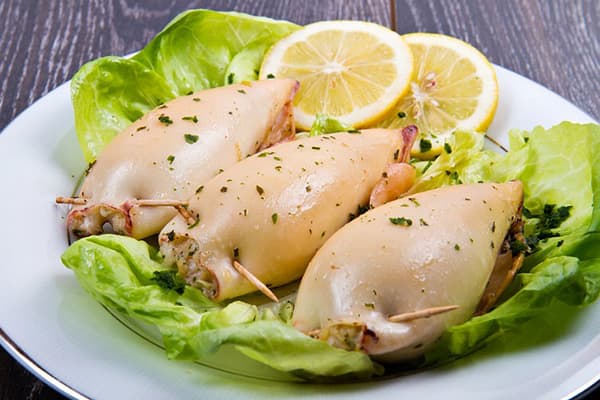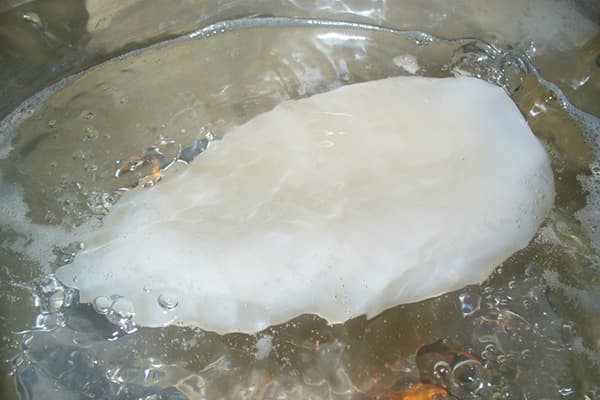How to properly cook frozen squid so that it is soft?
Squid is a delicacy product, for special occasions: it is not served daily. The less housewives have culinary experience working with shellfish. Some people don’t know how to clean it, others claim that after cooking the protein becomes just rubbery. How to cook squid correctly so as not to spoil it? How do you even handle them?

Save benefits
Squid pulp is very useful, first of all, for our heart, as it contains a large amount of potassium. In addition, it is rich in magnesium, phosphorus, and vitamins. There are practically no carbohydrates in this meat, and only 3% fat. Everything else is valuable protein that is easily digestible. Therefore, the main task when preparing shellfish is to preserve their benefits and nutritional value, and also to do everything to ensure that the carcasses are soft and tender.
Most housewives know that prolonged heat treatment can destroy many valuable protein substances. But not everyone knows that it is also the reason for the very “rubberized” appearance of squid. We are accustomed to the fact that animal proteins in one form or another must be cooked for a very long time. Therefore, “by default” we apply this rule to mollusks, which in fact are an exception.
It is generally customary for the Japanese to eat squid almost raw; they are only lightly doused with boiling water. But eating half-raw meat is alien to our traditions, so you still need to boil the carcasses, although much less than usual.
Before cooking
Carcasses are usually sold frozen, in a semi-cut state. Therefore, before cooking, they must be defrosted and then cleaned. Carcasses should be defrosted under natural conditions, without forcing events. That is, they are either placed on the lowest shelf of the refrigerator, or left in the kitchen at room temperature. No “accelerating” immersions in hot or cold water, no defrosting using a microwave: all this will significantly worsen the taste and tenderness of the shellfish.
On top they are covered with a thin film-skin. There are many ways how to remove film from squid: it doesn’t matter how you get rid of it, the main thing is to remove it, otherwise it will give the finished dish an unpleasant sour-bitter taste. In addition, inside the squid there is a “spine” - a chord resembling a plastic “braid”, which is also removed.
How to do it? You can remove the film in the same way as removing the skin, for example, from tomatoes: put it in a bowl, pour boiling water over it, and then immediately dip it in a bowl with as cold water as possible. Due to a sharp temperature change, the skin will immediately peel off. All that remains is to pick it up and pull it off like a stocking. You need to feel the chord with your fingers and just pull it.
At this point, the preliminary stage is completed - you can proceed directly to cooking. But this is the case if frozen carcasses were purchased without heads and tentacles. If the carcass was purchased uncut, you will also have to remove the head, entrails, and tentacles. To do this, you need to grab your head at the place where it connects to the body (behind the eyes) and pull.
Whether to add any spices to the water for boiling squid is a matter of preference. If squid is cooked for salad, usually only salt is added to taste.If you plan to stuff shellfish or serve them with any sauce, you can also add:
- onion;
- Bay leaf;
- peppercorns;
- carrot;
- dill;
- lemon juice;
- cloves;
- parsley root.
How long to cook squid?
Cooking squid correctly means quickly. That is, exposure to high temperatures should be kept to a minimum.
There are 5 main ways to cook squid:
- The water is brought to a boil, salted, then the shellfish are immersed in it, and they are cooked for about 40-50 seconds, after which the carcasses must be removed. You can keep them in boiling water a little longer, but no more than 2 minutes, otherwise the squid will acquire that “rubbery” quality.
- The carcasses are not boiled at all, but simply subjected to short-term heat treatment: they are placed in a saucepan (but not put on fire!), poured with boiling water, covered with a lid and left to simmer for about 3-4 minutes.
- With this method, shellfish are also not literally boiled. They are simply doused with boiling water several times: the first - when this is done to remove the film, the second and third - after the skin has already been removed. The length of time the carcasses remain in boiling water is a minute each time.
- The water is brought to a boil, salted, squid carcasses are lowered into it in a metal sieve for literally 5-10 seconds and immediately removed. When the water boils again, lower the squid again for the same time. After this, they are cooled and then prepared according to the chosen recipe.
- In the same way, boil water, lower the carcasses into the pan, cover and immediately turn off the heat without removing the dishes from the burner. The shellfish are left in the pan for 3-4 minutes, after which they are taken out, allowed to cool and prepared for the main dish.
If you are distracted and the clams are boiling for more than 2 minutes, do not worry: they can still be saved.Reduce heat and cook them for another 40–50 minutes. After this, the protein will become soft again. True, the carcasses themselves will become much smaller, but you will receive as a bonus a fragrant, rich broth that can be used to prepare seafood soup.
Alternative cooking methods
You can cook squid in other ways.
- For example, when you’re really pressed for time, you can boil them by taking them straight from the freezer, without first defrosting them. To do this, you need to boil water, add salt and spices to taste, put squid in boiling water, set a minute and turn off the heat. After 10 minutes, you can remove the pan from the stove.
It should be remembered that with this method the skin will almost come off by itself, but you still need to pull out the chord. - Another option involves placing the shellfish in a pan with still cold water and placing it over medium heat. After the water is heated, it is added salt. After boiling, the burner is turned off, and the carcasses are immediately pulled out.
- You can cook squid in the microwave. To do this, they are defrosted, cleaned, placed in a microwave-safe dish, water is poured in and cooked at maximum power for about 2 minutes. When cooked without water, they will begin to behave like eggs (explode and “shoot”).
- If your household has a double boiler, you can use it. After pouring water into the container and placing the carcasses in the bowl, close the steamer and turn on the timer for 7–8 minutes. There is no need to open or try anything during cooking. This is done after the timer has turned off.
- A slow cooker is also suitable for this purpose. The water in it is first brought to a boil, then shellfish, salt, spices are added and the required cooking time is set. This can be either 1 minute (most often) or all 40.It depends on the final purpose of cooking. Some dishes suggest that squid should be cooked for a very long time (by the way, some peoples have similar recipes for eggs - not the usual 10 minutes, but several hours!).
It follows that a significant role in the question of how long squids are boiled is played by the recipe of the dish for which they are boiled. Sometimes you only need to pour boiling water over them to remove the thin outer skin (for example, if further marinating is intended).
Finally, one more piece of advice: don’t despair if you overcook the carcasses for the first time and they become denser. As you know, experience is the son of difficult mistakes. Without making a mistake, few people managed to understand how to do something correctly the first time (and even less so how to cook). Cooking is a very subjective activity. Here you need to learn to “feel” each product. And this takes time. And you can’t do without stuffing cones.


complete nonsense of taiga fishermen - squid is not boiled, but fried quickly and lightly, preferably deep-fried….